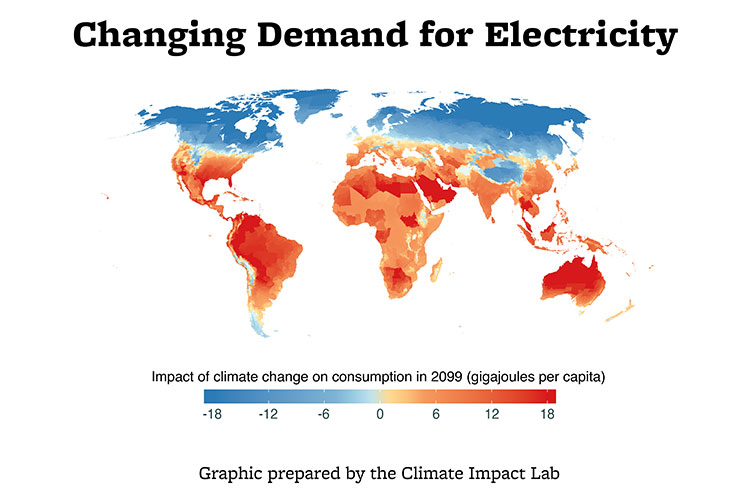Air conditioning in a changing climate: a growing rich-poor divide

As the earth’s climate warms, residents of affluent nations will find some relief with air conditioning, but people in lower-income countries may have to pay vastly more for electricity or do without cooling, says a new study co-authored at the University of California, Berkeley.

The research, published today in Nature, provides a dramatic new view of how climate change will aggravate the global gap between rich and poor nations. It found that even as temperatures rise, electricity consumption in the U.S. might increase only slightly by the end of the century. But in some emerging countries, demand for energy could rise dramatically as residents seek access to air conditioning, while others will still be so poor that air conditioning will remain an inaccessible dream, the researchers found.
Earlier models, based on broad assumptions and limited data, predicted that rising temperatures would impose dramatic new costs — the “social costs of carbon” — across much of the globe. But those models were flawed because they were based only on conditions in affluent nations, said lead author Solomon Hsiang, co-director of the Climate Impact Lab and professor of public policy at UC Berkeley.
“Prior analyses ignored energy usage data from the developing world, where billions live in poverty and lack energy access,” Hsiang said. “Studies simply assumed people everywhere behaved similar to the U.S. or the U.K. But their conclusions were exactly backward. Our data show that richer populations can protect themselves from the impacts of warming, but the global poor don’t have this luxury.”

Ashwin Rode, director of scientific research at the Energy Policy Institute at the University of Chicago and a member of the Climate Impact Lab, illustrated the point with stark data:
“While some form of air conditioning is present in 90% of homes in the United States,” Rode explained, “this is currently true for only 5% of homes in India. As climate change causes heat waves to become more intense and frequent in future decades, the data show that electricity to power cooling technology, like fans or air conditioners, remains out of reach for more than half of the global population.”
The Climate Impact Lab is a joint initiative by more than 30 researchers from the Rhodium Group; the Rutgers Institute of Earth, Ocean, and Atmospheric Sciences at Rutgers University; the Bren School of Environmental Science and Management at University of California, Santa Barbara; the University of Delaware; Princeton University; Fudan University in China; the University of Chicago and UC Berkeley.
A major project for the Climate Impact Lab researchers is to measure the social costs of carbon using economic statistics and big data analytics more powerful than any tools previously used in the field. The analysis of expected energy use and costs is the first published paper in a series that is expected to look at the social costs of carbon reflected in agriculture, health, labor, sea level rise and other areas.
Such research is already having a profound impact as global leaders work to develop policies that limit climate change and mitigate its human impact. Earlier this year, U.S. President Joe Biden issued executive orders directing key regulators to assess the economic risks posed by climate change and to address the equity implications of environmental changes, both topics addressed by the new study.
“Our hope is that the best available data-driven science will be used to design climate change policies in the U.S. and internationally,” Hsiang explained. “Our children and grandchildren cannot afford for us to make these decisions based on intuition or gut feelings.” Researchers at the Global Policy Lab in UC Berkeley’s Goldman School of Public Policy have been crunching numbers for five years to help bring this vision to life, he added.
In its basic form, the social cost of carbon is the most holistic way of looking at the impact on humans of each additional ton of climate warming carbon dioxide and other greenhouse gases pumped into the atmosphere.
Seen through a global lens, the numbers reported in the new Climate Impact Lab research seem almost like good news:
For every ton of carbon dioxide released into the atmosphere now, the research found, annual energy expenditures across a warming world would fall by $1 to $3. The world emits more than 30 billion tons of carbon dioxide into the atmosphere every year, and that computes to a savings of up to 0.17% of the world’s gross domestic product, they authors concluded.
But these global numbers hide important disparities between rich nations in relatively temperate zones and poor nations that are often closer to the equator. The impacts of climate change on electricity usage could be mild for some and severe for others.
The research found that demand for electricity in the U.S. is likely to rise by a modest 2.7% by 2099. But in Indonesia, it could rise by nearly 100% by the end of the century, and in India by 145%. In Africa, Ethiopia would see demand more than triple, while in Nigeria it is projected to rise by nearly 2,100%.
In emerging countries such as India, Nigeria and Mexico, more people may be able to access air conditioning as the years pass. But, the researchers said, this demand will pose challenges for the electricity grid, and for policymakers who have to plan and maintain the energy infrastructure.
The new findings demonstrate “the critical role of economic development in shaping how energy consumption patterns respond to climate change,” the paper concludes. “We find that much of the world will remain too poor in the coming decades to spend substantially on energy-intensive cooling technologies.”
